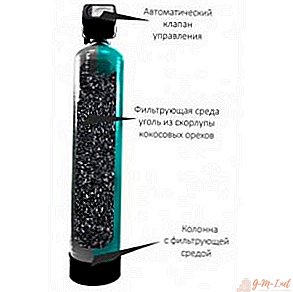 This device is necessary for every self-respecting person. As for the appearance itself, it is a plastic surface that is designed for mineral water, and activated coconut charcoal itself. These are the two most significant components of the unit. The casing itself is equipped with a special system inside, which includes a pipe, a distributor and a valve that controls the frequency and duration of flushing. In addition, the control unit is able to provide the main operating modes: filtration, reverse (where the liquid enters the cleaned) and direct flushing (sent to the sewer line). Many people wonder - what does a carbon filter for water clean? Find the answer to it.
This device is necessary for every self-respecting person. As for the appearance itself, it is a plastic surface that is designed for mineral water, and activated coconut charcoal itself. These are the two most significant components of the unit. The casing itself is equipped with a special system inside, which includes a pipe, a distributor and a valve that controls the frequency and duration of flushing. In addition, the control unit is able to provide the main operating modes: filtration, reverse (where the liquid enters the cleaned) and direct flushing (sent to the sewer line). Many people wonder - what does a carbon filter for water clean? Find the answer to it.
Charcoal filter action - how and what it cleans
The principle of its operation is quite simple and effective: it is filled with activated carbon. Precisely because such a load has sorption ability.
Water flows from the top to the bottom through it. In the meantime, the liquid is purified from various contaminants. This process is also characterized by the depletion of the capacity in which the coal is located.For a more optimal process, it is desirable to observe the humidity in the room - not higher than 70%.
ATTENTION. Performance is periodic. This means that the entire cycle must be carried out with a certain time interval, and it is better at night. Namely, from one to two hours several times a week.
Most often, this design is installed at the last level of water purification. However, the user can apply it both separately from all filters, and together with them.
REFERENCE! Cylinders can be used in pairs, which significantly improves the cleaning process.

The main purpose of the carbon filter
The main goal of the work is to effectively and maximally eliminate impurities from the water stream. These may include:
 Undesirable taste and smell.
Undesirable taste and smell.- Organics and organic compounds, microorganisms.
- Suspension and / or algae, uncharacteristic color.
- Excessive active chlorine.
- Iron, various types of precipitation, rust.
- Disinfectant formulations.
- Chlorine
- Turbidity.
However, it is important to remember that a variety of salts and bacteria is not a way to eliminate the device. This is done using other additional devices. And also if you use them, then you can avoid particles that are most likely exfoliated. Apply them as another cleaning step.
In addition to the above, the technology is not intended for the implementation of the system in hot water supply and near all varieties of the heater, since there is a high probability of losing the necessary qualities and properties of the device.

 Undesirable taste and smell.
Undesirable taste and smell.
Leave Your Comment